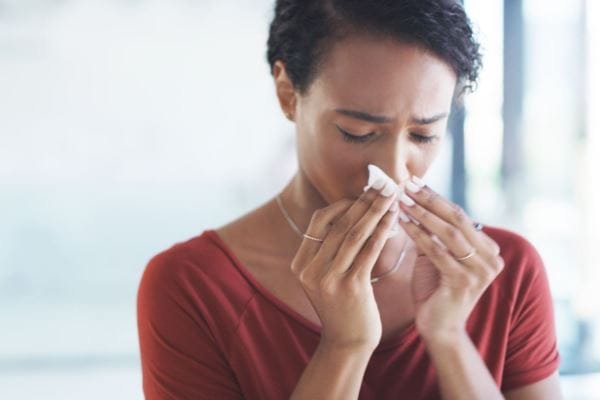With similar symptoms, it can be difficult to know what type of respiratory infection you may have.
Posted
by Featured Provider Michael Sinklier on Thursday, October 1, 2020
 When it comes to cold and flu season, the onset of sneezes and sniffles aren’t ever something to look forward to. But with COVID-19 now in the mix, those same (even minor) symptoms can be anxiety-inducing on top of making you feel sick.
When it comes to cold and flu season, the onset of sneezes and sniffles aren’t ever something to look forward to. But with COVID-19 now in the mix, those same (even minor) symptoms can be anxiety-inducing on top of making you feel sick.
Though these respiratory illnesses are all contagious, different viruses are responsible for each. Generally, the symptoms of the flu can be worse than the common cold, and COVID-19 can fall anywhere on the severity spectrum — some people might not show any symptoms at all.
All three illnesses can be transmitted person-to-person or between people in close contact, mainly through droplets created when someone coughs, sneezes or talks.
How do cold, flu and COVID-19 symptoms stack up?
Usually, flu symptoms appear between one and four days after someone is initially infected, and cold symptoms appear between one and three days later. For COVID-19, anywhere between two and 14 days may pass, but usually symptoms appear around day five. The following chart identifies the common symptoms of COVID-19 (but not all of them), the flu and the common cold.
|
Symptom
|
Cold
|
Flu
|
COVID-19
|
|
Fever
|
|
X
|
X
|
|
Chills
|
|
X
|
X
|
|
Cough
|
X
|
X
|
X
|
|
Sore Throat
|
X
|
X
|
X
|
|
Congestion or Runny Nose
|
X
|
X
|
X
|
|
Shortness of Breath/Difficulty Breathing
|
|
|
X
|
|
Nausea
|
|
X
|
X
|
|
Vomiting
|
|
X
|
X
|
|
Diarrhea
|
|
X
|
X
|
|
Fatigue
|
X
|
X
|
X
|
|
Muscle Aches
|
X
|
X
|
X
|
|
Loss of Taste or Smell
|
|
|
X
|
Source: Centers for Disease Control and Prevention (CDC).
Bottom line: With so many similarities, only a test will be able to confirm if your symptoms are COVID-19 or the flu (there is no test for the common cold). And it is possible to have both viruses — and other respiratory illnesses — at the same time.
Testing is time-sensitive, too. The most accurate windows for virus testing are between five and seven days after possible exposure to COVID-19. For the flu, tests should be done within the first 48 hours after the illness begins for available antiviral treatments to be effective, reminds family medicine provider Dr. Michael Sinklier.
First, stay home if you’re feeling sick. And seek out testing if needed.
It’s best to keep the health and safety of yourself and those around you top of mind. If you’re experiencing any of the above signs of a respiratory illness, stay at home and watch your symptoms. Focus on getting rest and staying hydrated. If symptoms get worse, reach out to your primary care provider. You may be able to set up a virtual care appointment and get tested for the coronavirus.
Current CDC recommendations say you should get tested if you’re experiencing any of the above symptoms of COVID-19 or if you’ve come into close contact with someone who has tested positive. In this instance, close contact means you’ve been within six feet of someone for 15 minutes or more.
Often, you will be tested for both the flu and COVID-19 if you are experiencing any of the above symptoms. “Symptoms such as fever, fatigue and body aches can occur with both illnesses,” says Dr. Sinklier, “So it is just as important to seek out medical care if you have symptoms of the flu.”
If your symptoms are severe, you should go to the nearest emergency department.
Understand how long to stay home, and when you can return to work or school.
For a cold and the flu, plan on staying home until you’ve been fever-free for at least 24 hours without the help of a fever-reducing medicine.
"When it comes to COVID-19 exposure," says Dr. Sinklier, "plan on isolating for 14 days after your last close contact with a positive-testing person." If you’ve tested positive for COVID-19, then you should stay isolated until 14 days after your positive test result, or 10 days since your last symptom (whichever is longer).
Once your symptoms have cleared and the recommended timeframe has passed, you’re able to return to work or school. Continue to wear a mask, wash your hands and maintain social distancing recommendations when out in public to help prevent the spread of these respiratory illnesses.
These eight virus prevention tips can help you stay healthy this season.
Sometimes, you just can’t help but catch a bug. But you can lessen your risk of coming down with the cold, flu or COVID-19 by staying on top of the following recommendations:
- Wash your hands frequently for a full 20 seconds with warm water and soap. Or in a pinch, use hand sanitizer with at least 60% alcohol.
- Wear a mask.
- Avoid touching your face, mouth and eyes.
- Cover your mouth and nose when coughing or sneezing in the crook of your elbow.
- Avoid shaking hands.
- Disinfect high-contact surfaces frequently.
- Maintain at least six feet between other people for proper social distancing.
- Get your flu shot!
And if you need care, we’re here to help.
Source: Centers for Disease Control and Prevention (CDC).
Meet This Featured Provider

Learn More About:
Family Medicine,
Primary Care,
Women's Center,
Men's Center
Michael Sinklier, DO joined The Iowa Clinic in 2020. After meeting several of our physicians, he was impressed by the highly qualified professionals that make up the organization. He feels honored to be part of a team that strives for excellence in patient care.
Dr. Sinklier chose famil... Read More
Accepting New Patients
Schedule Now
Other Coronavirus
Tags
- coronavirus
- primary care